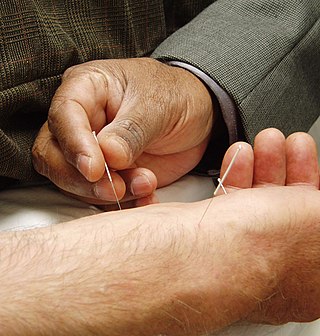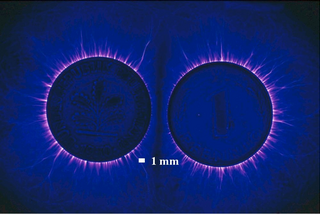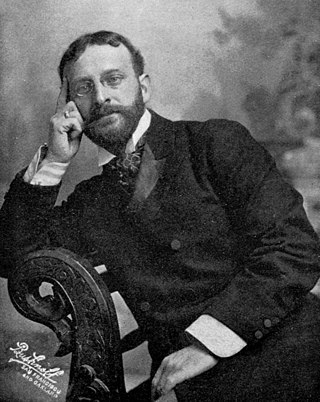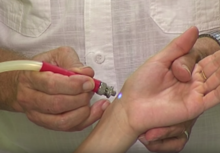
Acupuncture is a form of alternative medicine and a component of traditional Chinese medicine (TCM) in which thin needles are inserted into the body. Acupuncture is a pseudoscience; the theories and practices of TCM are not based on scientific knowledge, and it has been characterized as quackery.

Kirlian photography is a collection of photographic techniques used to capture the phenomenon of electrical coronal discharges. It is named after Soviet scientist Semyon Kirlian, who, in 1939, accidentally discovered that if an object on a photographic plate is connected to a high-voltage source, an image is produced on the photographic plate. The technique has been variously known as "electrography", "electrophotography", "corona discharge photography" (CDP), "bioelectrography", "gas discharge visualization (GDV)", "electrophotonic imaging (EPI)", and, in Russian literature, "Kirlianography".

Acupressure is an alternative medicine technique often used in conjunction with acupuncture or reflexology. It is based on the concept of life energy, which flows through "meridians" in the body. In treatment, physical pressure is applied to acupuncture points, or ashi trigger points, with the aim of clearing blockages in these meridians. Pressure may be applied by hand, by elbow, or with various devices.
Magnetic therapy is a pseudoscientific alternative medicine practice involving the weak static magnetic field produced by a permanent magnet which is placed on the body. It is similar to the alternative medicine practice of electromagnetic therapy, which uses a magnetic field generated by an electrically powered device. Magnet therapy products may include wristbands, jewelry, blankets, and wraps that have magnets incorporated into them.
The National Center for Complementary and Integrative Health (NCCIH) is a United States government agency which explores complementary and alternative medicine (CAM). It was initially created in 1991 as the Office of Alternative Medicine (OAM), and renamed the National Center for Complementary and Alternative Medicine (NCCAM) before receiving its current name in 2014. NCCIH is one of the 27 institutes and centers that make up the National Institutes of Health (NIH) within the United States Department of Health and Human Services.
Therapeutic touch, known by some as "non-contact therapeutic touch" (NCTT), is a pseudoscientific energy therapy which practitioners claim promotes healing and reduces pain and anxiety. "Therapeutic Touch" is a registered trademark in Canada for the "[s]tructured and standardized healing practice performed by practitioners trained to be sensitive to the receiver's energy field that surrounds the body;...no touching is required."

Emotional Freedom Techniques (EFT) is a technique that stimulates acupressure points by pressuring, tapping or rubbing while focusing on situations that represent personal fear or trauma. EFT draws on various theories of alternative medicine – including acupuncture, neuro-linguistic programming, energy medicine, and Thought Field Therapy (TFT). EFT also combines elements of exposure therapy, cognitive behavioral therapy and somatic stimulation. It is best known through Gary Craig's EFT Handbook, published in the late 1990s, and related books and workshops by a variety of teachers. EFT and similar techniques are often discussed under the umbrella term "energy psychology."

Chromotherapy, sometimes called color therapy, colorology or cromatherapy, is an alternative medicine that is considered pseudoscience and quackery. Chromotherapists claim to be able to use light in the form of color to balance "energy" lacking from a person's body, whether it be on physical, emotional, spiritual, or mental levels. For example, they thought that shining a colored light on a person would cure constipation. Historically chromotherapy has been associated with mysticism and occultism.

According to spiritual beliefs, an aura or energy field is a colored emanation said to enclose a human body or any animal or object. In some esoteric positions, the aura is described as a subtle body. Psychics and holistic medicine practitioners often claim to have the ability to see the size, color and type of vibration of an aura.

Breathwork is a term for various breathing practices in which the conscious control of breathing is said to influence a person's mental, emotional, or physical state, with a therapeutic effect.
Proponents and practitioners of various esoteric forms of spirituality and alternative medicine refer to a variety of claimed experiences and phenomena as being due to "energy" or "force" that defy measurement or experimentation, and thus are distinguished from the scientific form of energy.
Nambudripad's Allergy Elimination Techniques (NAET) is a form of alternative medicine which proponents claim can treat allergies and related disorders. The techniques were devised by Devi Nambudripad, a California-based chiropractor and acupuncturist, in 1983, drawing on a combination of ideas from applied kinesiology, acupuncture, acupressure, nutritional management, and chiropractic methods.
Jin Shin Do is a therapeutic acupressure technique developed by psychotherapist Iona Marsaa Teeguarden, beginning in the 1970s.

Energy medicine is a branch of alternative medicine based on a pseudo-scientific belief that healers can channel "healing energy" into a patient and effect positive results. The field is defined by shared beliefs and practices relating to mysticism and esotericism in the wider alternative medicine sphere rather than any sort of unified terminology, leading to terms such as energy healing or vibrational medicine being used as synonymous or alternative names. In most cases there is no empirically measurable energy involved: the term refers instead to so-called subtle energy. Practitioners may classify the practice as hands-on, hands-off, and distant where the patient and healer are in different locations. Many schools of energy healing exist using many names: for example, biofield energy healing, spiritual healing, contact healing, distant healing, therapeutic touch, Reiki or Qigong.

Radionics—also called electromagnetic therapy (EMT) and the Abrams Method—is a form of alternative medicine that claims that disease can be diagnosed and treated by applying electromagnetic radiation (EMR), such as radio waves, to the body from an electrically powered device. It is similar to magnet therapy, which also applies EMR to the body but uses a magnet that generates a static electromagnetic field.
Postural Integration is a type of bodywork purporting to draw on "energy" and allow access to the past. It was devised in the late 1960s by Jack Painter (1933–2010) in California, US, after exploration in the fields of humanistic psychology and the human potential movement.
In the Japanese medical tradition and in Japanese martial arts traditions, the word Hara is used as a technical term for a specific area (physical/anatomical) or energy field (physiological/energetic) of the body. An alternative Japanese reading of the character is Fuku, the Chinese reading is Fu.
Psychosensory therapy is a form of therapeutic treatment that uses sensory stimuli to affect psychological and emotional health. In addition, psychosensory therapy is a group of therapeutic techniques that involves applying sensory inputs to treat various behaviors, mood, thoughts, symptoms, and pain. Psychosensory therapy has its roots in traditional Chinese medicine in addition to energy psychology. Some important figures in psychosensory therapy include chiropractor George Goodheart, psychiatrist John Diamond, clinical psychologist Roger Callahan, and Ronald Ruden.










